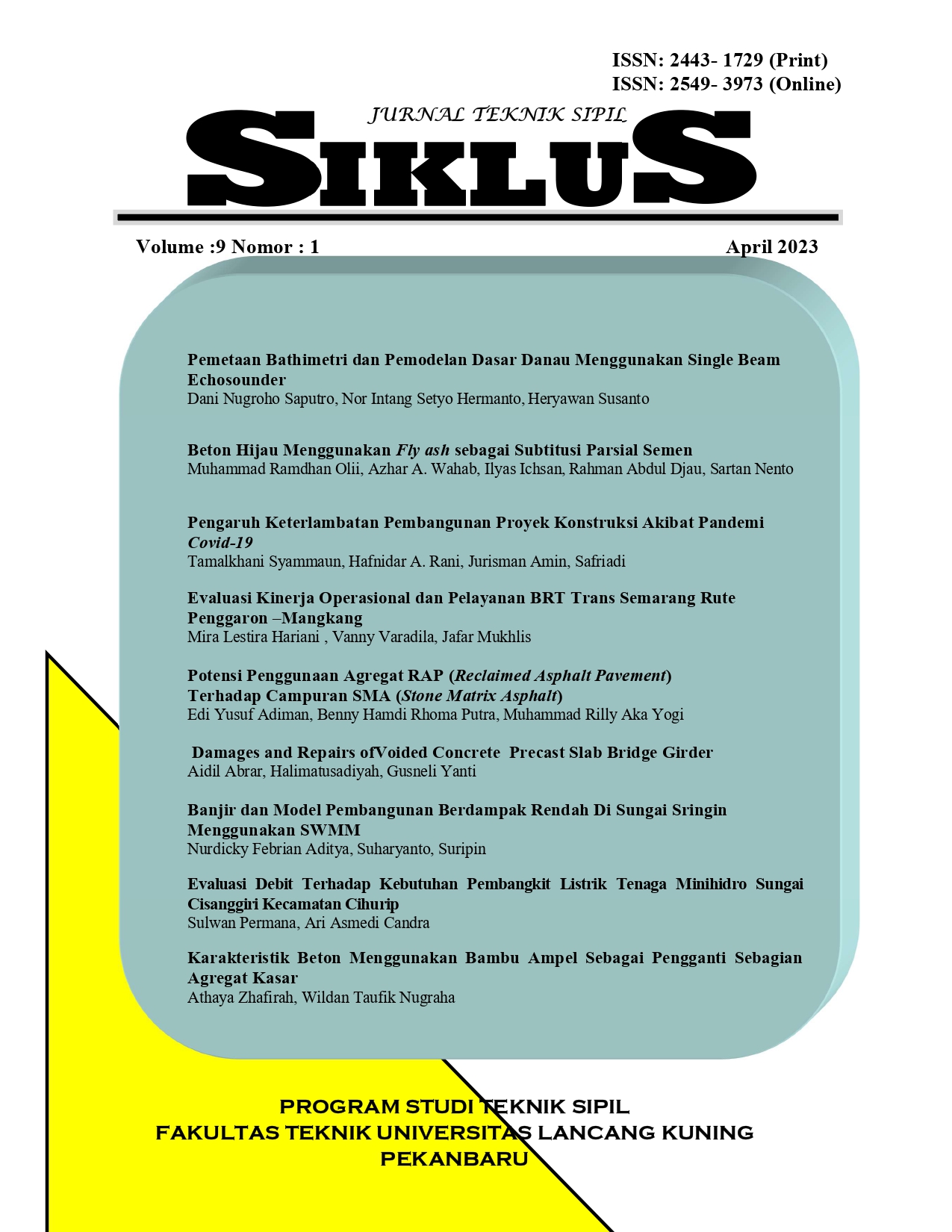Beton Hijau Menggunakan Fly ash sebagai Subtitusi Parsial Semen
Beton Hijau Menggunakan Fly ash sebagai Subtitusi Parsial Semen
DOI:
https://doi.org/10.31849/siklus.v9i1.11101Keywords:
Semen, Fly Ash, Beton Hijau, Kuat TekanAbstract
Perkembangan infrastruktur berbanding lurus dengan tingkat kebutuhan akan semen sebagai bahan utama dalam konstruksi bangunan. Industri semen menghasilkan 8-10% dari total emisi CO2 dunia. Penelitian ini bertujuan untuk menemukan alternatif atau penggantian sebagian material beton hijau sehingga meminimalkan dampak lingkungan dari pembuatan beton dan meningkatkan kekuatan beton, salah satunya adalah fly ash. Fly ash dapat digunakan bersama dengan semen portland dalam beton yang berkontribusi terhadap sifat-sifat beton melalui aktivitas hidrolik atau pozzolan, atau keduanya. Hasil pengujian kuat tekan karakteristik beton dengan substitusi parsial semen dengan variasi fly ash (9%, 9.5%, 10%, dan 10.5%) pada umur 28 hari adalah masing-masing 36.70 Mpa, 35.11 Mpa, 33.37 Mpa, dan 30.38 Mpa. Kuat tekan beton meningkat sebesar 5% pada variasi fly ash sebesar 9% dan 9.5% dan menurun sebesar 13% pada variasi fly ash sebesar 10% dan 10.5%. Dari hasil tersebut dapat disimpulkan bahwa semakin besar persentase penggunaan fly ash sebagai subtitusi parsial semen maka semakin menurun kuat tekannya. Jumlah optimum fly ash bervariasi sangat bergantung pada komposisi dan proporsi semua bahan dalam campuran beton (terutama fly ash), kondisi selama penempatan (terutama suhu), praktik konstruksi (misalnya, finishing dan curing) dan kondisi paparan. Dengan demikian, kadar fly ash yang optimal akan bervariasi berdasarkan kasus per kasus.
References
Anandan, S., & Manoharan, S. V. (2015). Strength properties of processed fly ash concrete. Journal of Engineering and Technological Sciences, 47(3), 320–334. https://doi.org/10.5614/j.eng.technol.sci.2015.47.3.7
Andrew, R. M. (2017). Global CO2 emissions from cement production. Earth System Science Data, August, 1–52.
Brunke, J. C., & Blesl, M. (2014). Energy conservation measures for the German cement industry and their ability to compensate for rising energy-related production costs. Journal of Cleaner Production, 82, 94–111. https://doi.org/10.1016/j.jclepro.2014.06.074
Chandio, S. A., Memon, B. A., Oad, M., Chandio, F. A., & Memon, M. U. (2020). Effect of Fly Ash on the Compressive Strength of Green Concrete. Engineering, Technology & Applied Science Research, 10(3), 5728–5731. https://doi.org/10.48084/etasr.3499
Ekaputri, J. J., Shahib, M., & Bari, A. (2020). Perbandingan Regulasi Fly Ash sebagai Limbah B3 di Indonesia dan Beberapa Negara. Media Komunikasi Teknik Sipil, 26(2), 150–162.
Gao, T., Shen, L., Shen, M., Liu, L., & Chen, F. (2016). Analysis of material flow and consumption in cement production process. Journal of Cleaner Production, 112(August), 553–565. https://doi.org/10.1016/j.jclepro.2015.08.054
Golewski, G. L. (2017). Green concrete composite incorporating fly ash with high strength and fracture toughness. Journal of Cleaner Production. https://doi.org/10.1016/j.jclepro.2017.10.065
Jin, S., Zhao, Z., Jiang, S., Sun, J., Pan, H., & Jiang, L. (2021). Comparison and summary of relevant standards for comprehensive utilization of fly ash at home and abroad. IOP Conference Series: Earth and Environmental Science, 621(1). https://doi.org/10.1088/1755-1315/621/1/012006
John, J. P. (2020). Parametric Studies of Cement Production Processes. Journal of Energy, 2020, 1–17. https://doi.org/10.1155/2020/4289043
Kim, J., Tae, S., & Kim, R. (2018). Theoretical study on the production of environment-friendly recycled cement using inorganic construction wastes as secondary materials in South Korea. Sustainability (Switzerland), 10(12), 1–14. https://doi.org/10.3390/su10124449
Kumar, N. (2021). A Review of Study on Green Concrete. International Journal for Research in Applied Science and Engineering Technology, 9(VII), 1525–1529. https://doi.org/10.22214/ijraset.2021.36623
Kusdiyono, Supriyadi, & Wahyono, H. L. (2017). Pengaruh Penambahan Fly Ash dan Bottom Ashpada Pembuatan Beton Mutu F’c 20 Mpa dalam Upaya Pemanfaatan Limbah Industri. Wahana Teknik Sipil, 22(1), 40–49.
Naqi, A., & Jang, J. G. (2019). Recent progress in green cement technology utilizing low-carbon emission fuels and raw materials: A review. Sustainability, 11(2), 1–18. https://doi.org/10.3390/su11020537
Olii, M. R., Poe, I. E., Ichsan, I., & Olii, A. (2021). Limbah Kaca Sebagai Penganti Sebagian Agregat Halus Untuk Beton Ramah Lingkungan. Teras Jurnal, 11(1), 113–124. https://doi.org/http://dx.doi.org/10.29103/tj.v11i1.407
Pangestuti, E. K., Handayani, S., Purnomo, M., Silitonga, D. C., & Fathoni, M. H. (2018). The Use of Fly Ash as Additive Material to High Strength Concrete. Jurnal Teknik Sipil Dan Perencanaan, 20(2), 65–70. https://doi.org/10.15294/jtsp.v20i2.16274
Pratiwi, W. D., Triwulan, Ekaputri, J. J., & Fansuri, H. (2020). Combination of precipitated-calcium carbonate substitution and dilute-alkali fly ash treatment in a very high-volume fly ash cement paste. Construction and Building Materials, 234, 117273. https://doi.org/10.1016/j.conbuildmat.2019.117273
Suhendro, B. (2014). Toward green concrete for better sustainable environment. Procedia Engineering, 95, 305–320. https://doi.org/10.1016/j.proeng.2014.12.190
Thomas, M. D. A. (2007). Optimizing the Use of Fly Ash in Concrete. Portland Cement Association, 24.
Tudjono, S., Purwanto, & Apsari, K. T. (2014). Study the effect of adding nano fly ash and nano lime to compressive strength of mortar. Procedia Engineering, 95(Scescm), 426–432. https://doi.org/10.1016/j.proeng.2014.12.202
Wattimena, O. K., Antoni, & Hardjito, D. (2017). A review on the effect of fly ash characteristics and their variations on the synthesis of fly ash based geopolymer. AIP Conference Proceedings, 1887(September). https://doi.org/10.1063/1.5003524
Zachar, J., Ph, D., & Asce, M. (2011). Sustainable and Economical Precast and Prestressed Concrete Using Fly Ash as a Cement Replacement. Journal Of Material s In Civil Engineering, 23(June), 789–792.
Zeggar, M. L., Azline, N., & Safiee, N. A. (2019). Fly ash as supplementry material in concrete : A review. IOP Conference Series: Earth and Environmental Science, 357(1). https://doi.org/10.1088/1755-1315/357/1/012025











_.jpg)


